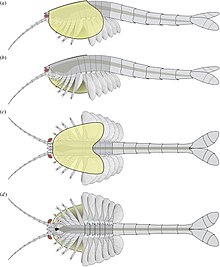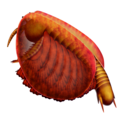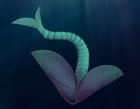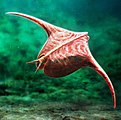Hymenocarina is an order of extinct arthropods known from the Cambrian. They possess bivalved carapaces, typically with exposed posteriors. Members of the group are morphologically diverse and had a variety of ecologies, including as filter feeders and as predators. Recent research has generally considered them to be stem or crown group members of Mandibulata, due to the presence of mandibles in some species.
| Hymenocarina Temporal range: | |
|---|---|
 | |
| Diagram of Waptia | |
 | |
| Fossil of Canadaspis perfecta | |
| Scientific classification | |
| Domain: | Eukaryota |
| Kingdom: | Animalia |
| Phylum: | Arthropoda |
| Clade: | Mandibulata |
| Order: | †Hymenocarina Størmer, 1944 |
| Genera | |
| |
| Synonyms | |
|
Canadaspidida Novozhilov in Orlov, 1960 | |
Taxonomy
Hymenocarines are characterized by the combination of following characters: bivalved, convex carapace covering cephalothoracic region; cephalothorax bearing multisegmented antennules and rounded mandibles, alongside post-maxillular limbs with spiny, subdivided basis and endopods with well-developed terminal claws; absence of appendages between antennules and mandibles; median sclerite and lobate protrusions located between compound eyes; posterior tagma (abdomen) with ring-like segments and terminated by a pair of well-developed caudal rami.[2][1]
Based on the interpretation of simple head region that possess only a few segments and appendages, hymenocarine taxa were thought to be part of the upper stem-group euarthropods in early and mid 2010s.[3][4][5][6][7][8][9][10] They later became widely accepted as mandibulates (jawed arthropods) after the discovery of their mandible-bearing mouthparts in late 2010s.[2][1][11][12] Since then, most phylogenetic analysis suggest hymenocarines represent part of the mandibulate stem-group,[2][13][1][14][15][16][17][18] with some results suggest a rather crownward position such as stem-pancrustaceans,[1][19][20][18] stem-myriapods,[1] stem-hexapods[16] or somewhere in-between the former taxa.[21]
Several subgroups within the order are recognised, including Waptiidae[1] and Protocarididae.[2] The internal relationships of Hymenocarina are unstable, and it is unclear whether the group is monophyletic or paraphyletic.[22][23]
Cambrian bivalved arthropods are now recognised to be a polyphyletic group, with other groups of bivalved arthropods such as the Isoxyida, Bradoriida and Phosphatocopina only distantly related to Hymenocarina.[17][24][25][26] Chuandianella a bivalved arthropod morphologically similar to Waptia and long thought to be closely related[1][21] was reinterpreted as a non-hymenocarine euarthropod based on a restudy published in 2022, which found that it definitely lacked mandibles, characteristic of true hymenocarines.[24]
Diversity
- Life restoration of Waptia
- Life restoration of Canadaspis laevigata
- Only 2 cm-long Fibulacaris is suggested to have swum upside down
- Large-sized Balhuticaris shows extreme multisegmentation with over 100 segments
- Unlike other taxa, eyes of possible hymenocarine Erjiecaris were probably placed over carapace
- The carapace of possible hymenocarine Pseudoarctolepis had wing-like projections
The group was very diverse in shape, with some forms like Waptia somewhat resembling shrimp,[1] and others like Odaraia having a large carapace and trifurcate tail.[27] The appendages showing various degrees of specialization across the group, ranging from the feathery gills of Waptia[1] to the robust claws of Tokummia.[2] They also had a wide range of sizes with some like Fibulacaris reaching a length of up to 2 cm (0.79 in) long,[28] while largest Balhuticaris reached 24.5 cm (9.6 in) long.[23] Hymenocarines are thought to have been ecologically diverse, with various forms occupying scavenging, predatory, deposit feeding and suspension feeding niches.[23]
References
Wikiwand in your browser!
Seamless Wikipedia browsing. On steroids.
Every time you click a link to Wikipedia, Wiktionary or Wikiquote in your browser's search results, it will show the modern Wikiwand interface.
Wikiwand extension is a five stars, simple, with minimum permission required to keep your browsing private, safe and transparent.








